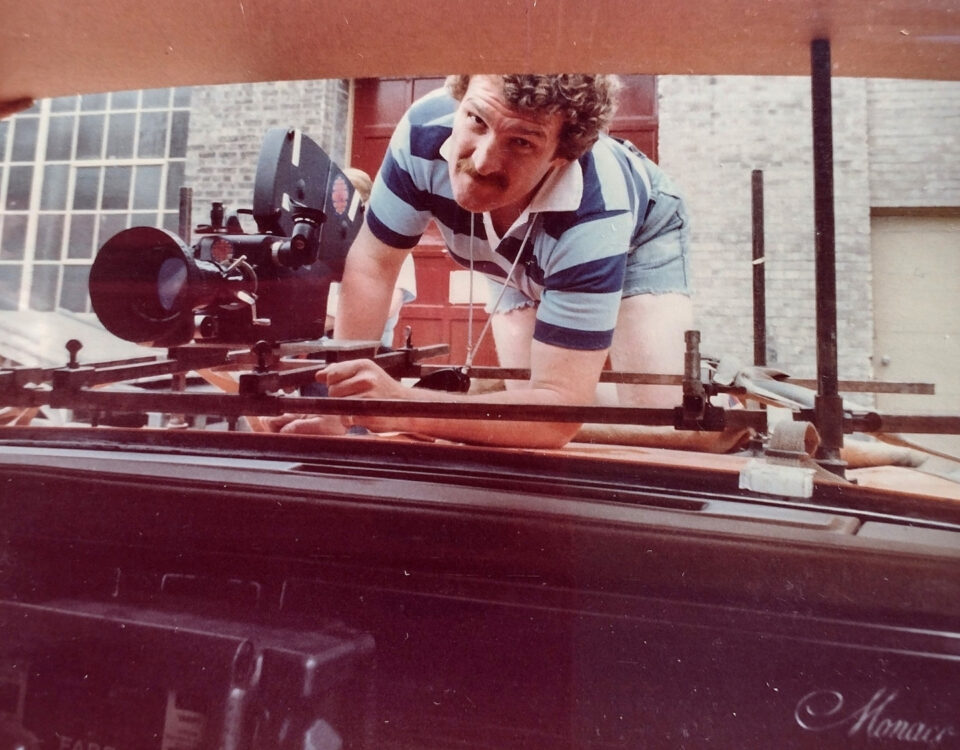
From behind the camera to behind the canvas
By Andrew Gray
When the BealART Secondary Art School in London accepted a passionate young Terry Culbert
many years ago the art life of an extraordinary renaissance man began to take form. From this
four-year program, Culbert cut his own path through numerous careers ranging from
photography, cinematography, radio broadcasting, and painting. He has authored and illustrated
two fine books, and continues his journey through new creative frontiers.
Culbert’s ancestral line immigrated from Ballymackey, Tipperary, Ireland and purchased land in
Biddulph Township (now part of Lucan in Southern Ontario) in 1840 – just a few years before the
arrival of the infamous family known as “The Black Donnellys” arrived, also from Tipperary.
“From what I was told, our family got along well with the Donnelly family.” While acknowledging
that the notoriously maligned family were surely no angels, Culbert feels that they incurred more
blame than they deserved.
“Without doubt, there was quite a lot of discrimination against the Donnellys. I find it quite
disturbing that the vigilante group that murdered six members of the Donnelly family was led by
the local Catholic priest.” Culbert’s ties to Lucan and Donnelly family lore are chronicled in the
second book, Lucan, Home of the Donnellys (2005).
At just 16, Culbert acquired his first professional camera and began working for The Exeter
Times Advocate and The London Free Press, capturing images of accidents, fires, parades, and
community events. This early experience set him on a path in photography and journalism.
One of his career highlights came in 1958 when Johnny Cash performed at the Lucan Arena.
Culbert captured a striking image of the country legend on stage. When Cash returned to Lucan
a few years later, Culbert took a chance, sending the photo backstage with the singer’s
bodyguard. “He came back a few moments later and said, ‘Mr. Cash wants to see you, son.’”
Not only did Culbert meet Cash in person, but the musician also signed the photo and hired him
to shoot two upcoming concerts.
Culbert’s career continued to evolve, and in 1969, as a newsreel cameraman, he covered a
major student demonstration on the Blue Water Bridge which connected Sarnia to Port Huron,
Michigan. It was a massive protest of the U.S. nuclear tests in the Aleutian Islands. When a car
from the U.S. refused to stop, driving into the crowd, the tense moment was captured on film.
“Nobody was hurt, but it was one of the scariest moments of my career,” Culbert recalls. That
footage earned him the inaugural Roy Tash Cameraman of the Year Award.
With this recognition, Culbert moved to Toronto and, within a few years, was hired by the CBC.
In 1978, CBC even strapped him to the hood of a taxi to film city footage for Saskatario. “I have
to say that the excitement of the shoot, the assignment, overpowered any safety concerns” he
admits.
Never one to shy away from a challenge, Culbert later worked on Conlon’s Ontario, taking on
assignments that pushed his limits. He ventured 1,800 feet below Lake Huron into the Goderich
Salt Mine and climbed to the top of the CN Tower, “secured by a rope lifeline as the tower
swayed in the wind.” Time and again, he embraced new challenges, excelling in his craft.
Culbert’s first book, Country Roads (1995) reflects his global adventures, but his work with
Global TV was a turning point. After a brief stint covering politics in Ottawa—where he found
daily media scrums creatively unfulfilling—he returned to Toronto as a cameraman-producer for
Bramah’s Ontario, a lifestyle-focused segment.
“My last eight years with Global TV were spent as Global’s first cameraman/reporter. I was self-
assigning, travelling anywhere in Ontario doing positive lifestyle stories. That aspect of
television work was by far my most enjoyable experience.”
Decades of carrying heavy cameras took a physical toll. Eventually, physical stress became a
major problem. By age 60, Culbert had to have a rotator cuff operation and, in his words, he
was “taken out to pasture.”
Suddenly finding himself with free time, Culbert began volunteering with “Island Radio” a small
local station on Amherst Island. Culbert had fun as the Friday morning DJ, covering community
events and helped fulfill a vital role in the community. After relocating to Prince Edward County,
he continued volunteering in local radio on Friday mornings, this time at 99.3 County FM.
Retirement also allowed Culbert to fully embrace painting, producing a remarkable body of work
often described as whimsical and vibrant. He and his wife, Barbara Hogenauer, an acclaimed
abstract artist, opened an in-house studio-gallery on Amherst Island more than 20 years ago.
“Even though our styles are very different, we have always enjoyed working together and
appreciate both of our different directions in painting.”
Culbert describes his approach to painting as detailed, precise and orderly, while Hogenauer’s
style is more loose and free. “Paint often splatters everywhere. It’s a good thing that we both
have a well-developed sense of humour.” For inspiration, they often take their passion for
sketching and painting on the road in their Roadtrek camper van which they call Painted Lady.
Their collaboration took an unexpected turn when Hogenauer, frustrated with a textured canvas,
was ready to abandon it. Culbert jokingly suggested adding one of his signature whimsical
characters—an idea that sparked a new artistic experiment.
“Surprisingly, we both liked the outcome and decided to run with that idea. Two artists working
on the same canvas needed a name – thus Hogbert came about, derived from our surnames
Hogenauer and Culbert. The Hogbert paintings have been very successful and enjoyable for us
to work on together.”
From behind the camera to behind the canvas, Terry Culbert’s life has been one of creativity,
adventure, and reinvention—a true renaissance man whose story continues to unfold.
countystudio.ca
This article was previously published in the Spring 2025 Vol. 34 No. 1 issue of Umbrella.


